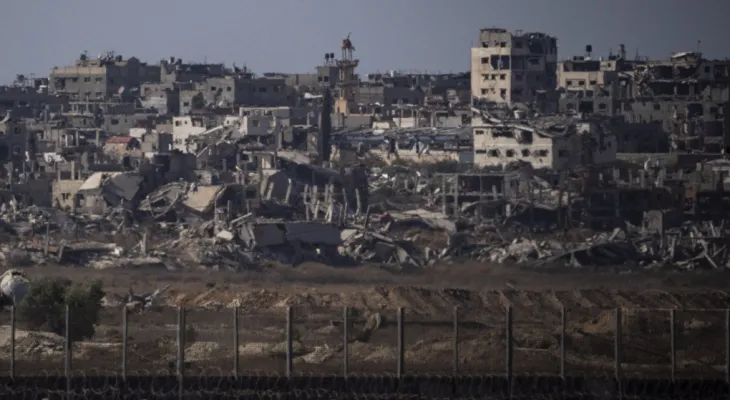Search here
Newspaper
Search here

Arab Canada News
News

Published: July 9, 2024
The Israeli forces have engaged in the largest city in the Gaza Strip to pursue activists who have reorganized there, prompting thousands of Palestinians to flee on Monday from an area devastated by the ongoing war for nine months in the early weeks.
Hamas warned that the recent airstrikes and evacuations in Gaza City could lead to the collapse of long-standing negotiations regarding a ceasefire and the release of hostages, after both sides appeared to have narrowed the gaps in recent days.
The Israeli forces are once again fighting activists in areas that the army said had been largely cleared months ago in northern Gaza. The army ordered evacuations before the airstrikes, but Palestinians said there is no safe place. Most of the 2.3 million residents have been displaced multiple times, often. Hundreds of thousands are crammed into extremely hot camps.
Israel ordered the evacuation of northern Gaza in the early weeks of the war and prevented most of the population from returning. However, hundreds of thousands of Palestinians still live in shelters or in the rubble of their homes.
A woman, Abed Al-Baqi, a mother of three who sought refuge with relatives in the Daraj neighborhood, said, "We fled in the dark amidst intense bombardment." "This is my fifth displacement."
Residents reported artillery and tank fire, as well as airstrikes. The Gaza health ministry, which has limited access to the north, did not immediately report any casualties.
Israel issued additional evacuation orders for areas in other neighborhoods in Gaza City. The army stated that it has intelligence showing the presence of Hamas and the smaller Islamic Jihad activists in the area, and urged residents to head south to the city of Deir al-Balah.
Israel accuses Hamas and other activists of hiding among civilians. In the Shujaiya neighborhood of Gaza City, which has witnessed weeks of fighting, the army claimed that forces raided and destroyed schools and a clinic that had been converted into militant compounds.
The war has devastated vast areas of urban regions and triggered a humanitarian disaster.
However, obstacles remain, even after Hamas agreed to retract its main demand that Israel commit to ending the war as part of any agreement. Officials told the Associated Press that the main part of this shift is the level of destruction caused by the ongoing Israeli assault.
Hamas still wants mediators to ensure that the negotiations conclude with a permanent ceasefire, according to officials familiar with the talks. The current draft states that the mediators – the United States, Qatar, and Egypt – "will do their utmost" to ensure that the negotiations lead to an agreement to end the war.
Israel has rejected any agreement that would force it to end the war with Hamas unchanged, a condition reaffirmed by Netanyahu on Sunday.
Hamas stated on Monday that it is "showing flexibility and positivity" to facilitate reaching an agreement, while Israeli Prime Minister Benjamin Netanyahu said that "more obstacles have been placed in the path of the negotiations."
On the other hand, the top political leader of Hamas, Ismail Haniyeh, warned the mediators of "catastrophic consequences" if Israel continues its operations in Gaza City, stating that Netanyahu and the army would bear "full responsibility" for the collapse of the talks, according to a later statement from the movement.
The officials said there is also a deadlock over whether Hamas can choose prominent prisoners held by Israel whom it wants released in exchange for the release of hostages. Some of the prisoners have been convicted of killing Israelis, and Israel does not want Hamas to determine who will be released. The officials spoke on condition of anonymity as they are not authorized to discuss sensitive talks with the media.
Bombardment keeps first responders away from bodies
Within Gaza, residents saw no end to their suffering.
Hala Mahfouz fled her home with her two children and several neighbors in the Zaitoun neighborhood of Gaza City. She added that their area was not listed in the recent evacuation orders, but "we feel panic because the bombardment and gunfire are too close to us."
Fadl Naim, director of the Al-Ahli Hospital, said patients fled the hospital despite there being no evacuation order for the surrounding area. He added that critically injured patients were transferred to other hospitals in northern Gaza.
Marwan Sultan, director of the Indonesian hospital, said the hospital received 80 patients and injured individuals, crammed into "every corner."
He said in a text message, "Many cases need urgent surgeries. Many cases suffer from direct gunshot wounds to the head and need intensive care. Fuel and medical supplies are dwindling." He added that the hospital also received 16 bodies of individuals killed in the Israeli incursion, half of whom were women and children.
Mohammed Basal, a spokesman for the civil defense working under the Hamas-run government, said that the neighborhoods of Al-Tuffah, Al-Daraj, and Shujaiya have become hard to access due to Israeli bombardment. He said in a voice message that the army bombed houses in the Yafa area of Gaza City and that rescuers "saw people lying on the ground and could not retrieve them."
The war has killed more than 38,000 people in Gaza, according to the health ministry, which does not distinguish between fighters and civilians in its tally.
The Hamas raid across the border on October 7 resulted in the deaths of 1,200 people in southern Israel, most of whom were civilians, according to Israeli authorities. The militants took nearly 250 people hostage. About 120 of them remain captive, and about a third of them are said to have died.
Comments